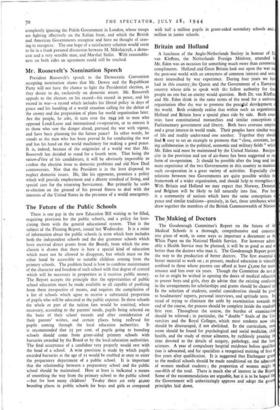The Future of the Public Schools
There is one gap in the new Education 'Bill waiting to be filled, requiring provision for the public schools, and a policy for tsso- ciating them with the general educational system. That is the subject of the Fleming Report, issued last Wednesday. It is a mine of information about the public schools (a term which here includes botb the independent schools and the day grammar schools which have received direct grants from the Board), from which the con- clusion is drawn that there is here a special kind of education which must not be allowed to disappear, but which must on the other hand be accessible to suitable children coming from the primary schools. The problem faced is how to combine maintenance of the character and freedom of each school with that degree of control which will be necessary in proportion as it receives public money. The Report accepts the principle that the opportunities of public school education must be made available to all capable of profiting from them irrespective of means, and requires the compilation of a list of schools which agree to receive a substantial proportion of pupils who will be educated at the public expense. In these schools the whole or part of the tuition fees would be remitted, where necessary, according to the parents' needs, pupils being selected on the basis of their school records and after consideration of their parents' wishes, and certain places being reserved for pupils coming through the local education authorities. It is recommended that 25 per cent. of pupils going to boarding schools should come from grant-aided primary schools with bursaries awarded by the Board or by the local education authorities. The final acceptance of a candidate very properly would rest with the head of a school. A wise provision is made by which pupils awarded bursaries at the age of 11 would be enabled at once to enter the preparatory department of a public school. It is important that the relationship between a preparatory school and the public school should be maintained. Here at least is indicated a means of smoothing the way from the primary school to the public school —but for how many children? To-day there are only 40,000 boarding places in public schools for boys and girls as compared with half a million pupils in grant-aided secondary schools and million in junior schools.


























 Previous page
Previous page